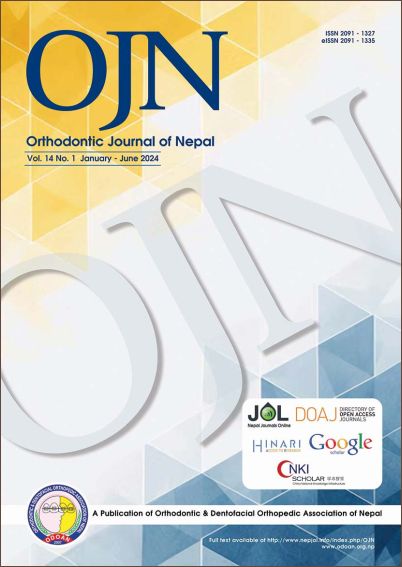Analysis of Skeletal and Dentoalveolar Components in Patient with Deep Bite Malocclusion
DOI:
https://doi.org/10.3126/ojn.v14i1.66899Keywords:
Cephalometry, Deep bite, MalocclusionAbstract
Introduction: Deep bite is a common malocclusion in the Nepalese population. Temporomandibular disorder, periodontal damage, teeth attrition and interference with mastication are the main consequences of deep bite. Various methods of deep bite correction are available. A good understanding of different underlying causes of deep bites may help in the selection of correct treatment modalities. The main objective of this study was to evaluate skeletal and dental components in the Nepalese population.
Material and Methods: Fifty cases of deep bite and fifty normal overbite cases were selected from 230 cases of the Department of Orthodontics, CMC, Chitwan. Manual cephalometric tracing and dental cast measurement were conducted for seventeen skeletal and twelve dental components of deep bite. Mann-Whitney U Test and Pearson correlation test were performed for evaluation of the effect of different components and interobserver reliabilities respectively.
Result: Among all skeletal components, Gonial angle (p=0.004, occurrence=72%), lower facial height/upper facial height×100 (p=0.014, occurrence =72%), lower facial height/total facial height×100 (p=0.02, occurrence=68%) and Mandibular plane angle (P=0.037, occurrence 63%) had major role. Among the dental components, overjet (p=0.001, occurrence=90%) and curve of Spee (p=0.001, occurrence 84 %) had the highest effect on deep bite. Saddle angle and lower molar length had the least effect on deep bite.
Conclusion: Among the skeletal components, gonial angle, lower facial height to upper facial height ratio, lower facial height to total facial height ratio and mandibular plane angle contributed the most to deep bite development. Increased overjet and curve of Spee among were the dental components with great role in deep bite. Saddle angle and lower molar length had the least contribution to deep bite development.
Downloads
Downloads
Published
How to Cite
Issue
Section
License
Copyright (c) 2024 Orthodontic & Dentofacial Orthopedic Association of Nepal

This work is licensed under a Creative Commons Attribution 4.0 International License.
Copyright © held by Orthodontic & Dentofacial Orthopedic Association of Nepal
- Copyright on any research article is transferred in full to the Orthodontic & Dentofacial Orthopedic Association of Nepal upon publication in the journal. The copyright transfer includes the right to reproduce and distribute the article in any form of reproduction (printing, electronic media or any other form).
- Articles in the Orthodontic Journal of Nepal are Open Access articles published under the Creative Commons CC BY License (https://creativecommons.org/licenses/by/4.0/)
- This license permits use, distribution and reproduction in any medium, provided the original work is properly cited.




